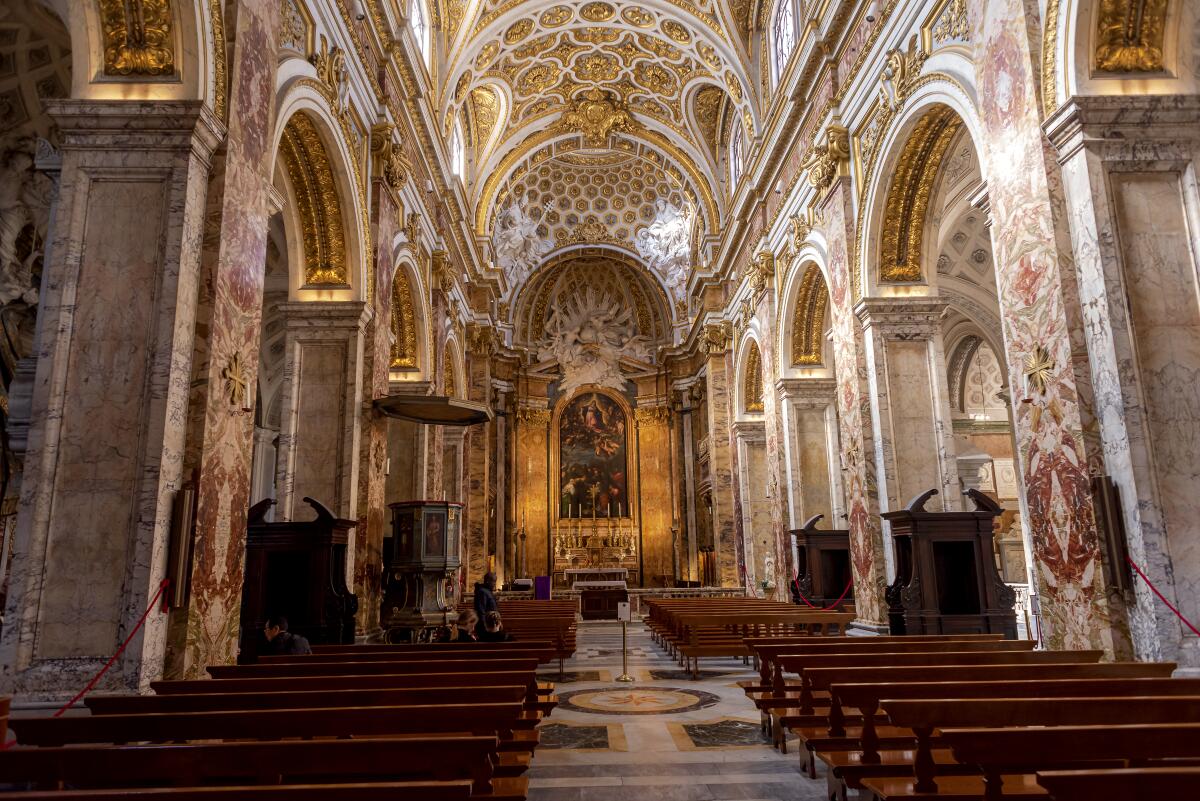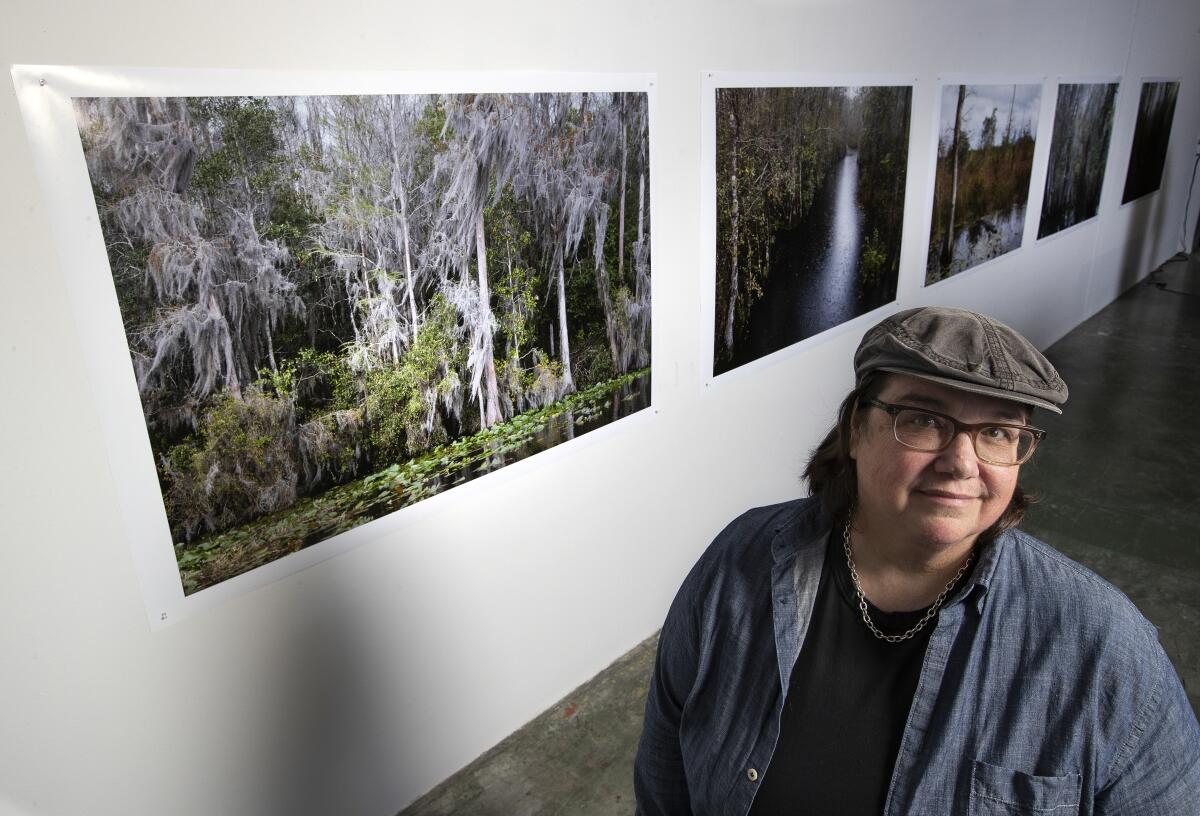Essential Arts: The world of culture feels the impact of coronavirus

- Share via
Love in the time of cholera. Art in the time of coronavirus. I’m Carolina A. Miranda, staff writer at the Los Angeles Times, with everything happening in the world of culture:
Coronavirus hits culture
The novel coronavirus has affected cultural institutions the world over, with movie theaters and film shoots closing down in China and the shuttering of La Scala in Milan. The Times’ Ashley Lee reports on how SoCal institutions have been preparing to contend with the virus, including establishing task forces and canceling employee travel to virus hot spots. Museums in New York have undertaken similar measures.
The Louvre Museum in Paris briefly closed and then reopened this week after management implemented measures to ease worker fears about the virus. Italy, which also had closed its museums, has now reopened them, with a new rule: Visitors must stay a meter apart from one another. The Venice Architecture Biennale, in the meantime, has been postponed from May to August due to the outbreak in Italy.

As of Friday, health officials in Santa Clara County, Calif., were urging residents and businesses to postpone or cancel large gatherings or public events, not to shake hands and to stand six feet apart.
Make the most of L.A.
Get our guide to events and happenings in the SoCal arts scene. In your inbox every Monday and Friday morning.
You may occasionally receive promotional content from the Los Angeles Times.
In Los Angeles, the 12th annual Nowruz festival celebrating the Iranian new year has been canceled, reports The Times’ Deborah Vankin. Last year the festival drew 25,000 people to UCLA. While the City of L.A.’s posted recommendations urge vigilance, they do not explicitly advise people to avoid public gatherings at this point.
The L.A. Phil hasn’t canceled any events but has been telling ticket holders that if they or a family member are sick, to please stay home: “We will exchange your tickets for another future performance with no fee.” In addition, late Friday it was announced that the South by Southwest festival in Austin, Texas, would be canceled.
You can find all the Times’ latest reporting on coronavirus at latimes.com/coronavirus. The Times now has a daily newsletter so that you can stay up to date on what’s happening, what it means and what measures you may need to take.
The good news in all of this? Books about plagues are hot.
In the galleries
Times art critic Christopher Knight reports on the “terrific” exhibition of Michelangelo’s drawings at the Getty Museum. The exhibition is special for a variety of reasons — the artist’s depth of skill and the show’s deft installation — but also because Michelangelo drawings are rare. “The artist made thousands of drawings,” writes Knight. “Only some 600 exist today. Proud and paranoid, Michelangelo burned stacks of them to prevent what he feared would be theft of his work by other artists.”
At the Huntington Library, Knight checks out the L.A. debut of British painter Lynette Yiadom-Boakye. These hang outside the portrait gallery where “Blue Boy” and “Pinkie” are generally displayed. The show, which comments on the nature of portraiture as much as it does on colonial economies, was organized by the Yale Center for British Art and New Yorker critic Hilton Als, whose selection, notes Knight, “has a cinematic quality.”
Contributor Leah Ollman reviews a show of work at Tanya Bonakdar Gallery by Lisa Oppenheim, an artist who “has long been fascinated with the representational capacity and limitations of photography.” Her “Landscape Portraits,” made by placing thin sheets of wood veneer on photo-sensitive paper, present “a Rorschach of possibilities.”
Enjoying this newsletter? Consider subscribing to the Los Angeles Times
Your support helps us deliver the news that matters most. Become a subscriber.
ArtCenter College of Design in Pasadena is taking a hard look at itself with a series of projects inspired by a somewhat dire statistic: Of all the school’s alumni, only about 1% are black. This includes a video survey, a retrospective of photographer Barbara DuMetz and a group exhibition curated by artist Devin Troy Strother. Strother tells Makeda Easter that the effort is a way of showing that “you can be young and black and actually have a working career within the art world and still be critical of the way institutions work.”
In the meantime, I interview photographer Catherine Opie, who is showing new images at Regen Projects inspired by the political rhetoric of “drain the swamp.” She tells me: “I was thinking about what it means to make political work that doesn’t hit you over the head with being political work.”

Design time
The big news in the world of architecture is that two women won the Pritzker Architecture Prize, a first for the male-centric prize. Yvonne Farrell and Shelley McNamara of Ireland’s Grafton Architects were selected for buildings that eschew “grand or frivolous gestures” but nonetheless bear a “monumental” institutional presence. I had the good fortune to meet the architects two years ago at the Venice Architecture Biennale. They are a decidedly low-key duo in a field known for its gassy bombast.
Classical notes
The L.A. Phil’s Power to the People! festival, which Gustavo Dudamel is cocurating with Herbie Hancock, will spotlight ideas connected to protest and the will of the people. Times classical music critic Mark Swed reports that in advance of that series, the philharmonic’s concerts devoted to the work of composer Charles Ives can be seen as setting the stage for this. Ives, he writes, “made the symphonies represent divisive current issues in a far greater complexity than we get in our normal public discourse.”
“Sweet Land,” the new opera by the Industry, codirected by Yuval Sharon and multimedia artist Cannupa Hanska Luger, whose themes deal with the history of colonization, is now underway at Los Angeles State Historic Park in downtown Los Angeles. The work, writes Swed, “is anything but sweet. Prepare for the world we live in, the place we inhabit and the progress we hope for it to lose a significant amount of its sugar content.”

On the stage
In the summer of 2013, Jeffrey Seller set aside a musical inspired by J.M. Barrie’s Peter Pan novel and went to work on an upstart musical called “Hamilton” instead. Now that he has that smash show and his fifth Tony Award behind him, he is back on the Wendy-centric musical, titled “Fly,” opening Sunday at the La Jolla Playhouse. The Times’ Ashley Lee sat down with the director for a Q&A.
The Antaeus Theatre Company’s current production of “Measure for Measure,” about a woman who is sexually blackmailed by a powerful man, bears some parallels to the headlines in the news. “Think of it as the #TheeToo movement,” writes contributor Tom Jacobs, about how Shakespeare’s text remains incredibly prescient.
Plus, American Ballet Theatre choreographer Alexei Ratmansky has made his first long-form ballet for the company, “Of Love and Rage,” which premiered this week in Costa Mesa. As Ratmansky tells contributor Jordan Riefe: “It’s vital to try on new things and create new titles.”
Play that funky music
Times staff writer Michael Ordoña has a roundup of videos of political candidates dancing, including some uncomfortable video of Tom Steyer working it to Juvenile. Since the politicos are obviously in dire need of dance coaching, I asked Times staff writer Makeda Easter, who covers dance (and is a dancer herself), to offer some pro tips: “My advice to Tom Steyer and any other presidential candidate who thinks dancing will earn them cool points with young people, is just don’t. Please. But if I had to offer something more tangible, I would’ve wanted Tom to bend his knees a little more as he was attempting to get down.”
Passages
Henry Cobb, a partner at the New York-based firm Pei Cobb Freed & Partners and the architect behind L.A.’s U.S. Bank Tower, has died at the age of 93. He did not have the high profile of architects such as his partner I.M. Pei, notes the New York Times obit. “He called them ‘formgivers’ and himself ‘a problem-solver.’”
Critic Mark Lamster examines the architect’s legacy in Dallas, including his design of the “rocket-shaped Fountain Place (1986), easily the most dynamic skyscraper on the city’s formidable skyline.”
And I look at how Cobb gave the L.A. skyline its distinctive crown in the form of the U.S. Bank Tower — for decades, the tallest building in Los Angeles.
Ready for the weekend
I’ve got the latest SoCal arts openings in my weekly Datebook, including the Los Angeles premiere of Isaac Julien’s 2010 film “Better Life (Ten Thousand Waves)” at REDCAT.
Plus, Matt Cooper rounds up the eight best things to do around L.A. and O.C. this week, including a musical drama inspired by Octavia Butler’s “Parable of the Sower” at UCLA.
Find all your week-ahead recommendations in our “Things to Do: Arts and Culture” page.
In other news
— How everything became “curated.”
— How poet and author Tess Taylor followed in the footsteps of the great Depression-era photographer Dorothea Lange.
— Cuban artist Luis Manuel Otero Alcántara was arrested and will face a summary trial after participating in anti-censorship protest.
— Richard Neutra’s Lovell Health House is for sale. Coincidentally, I need a raise.
— Mimi Zeiger has a great piece on how a tome devoted to women architects still reinforces the idea of the individual over the collective endeavor that architecture requires.
— “Architecture is culture in the making — it is an accessible way in which to share common values and become intertwined with the ideological project of modernity.” USC’s architecture dean, Milton Curry, pens an op-ed on the federal government’s draft plan to make federal buildings classical.
And last but not least ...
And since we’re on the subject of the draft plan for federal buildings: Reimagining Trump’s architectural holdings in a neoclassical style.
The biggest entertainment stories
Get our big stories about Hollywood, film, television, music, arts, culture and more right in your inbox as soon as they publish.
You may occasionally receive promotional content from the Los Angeles Times.




